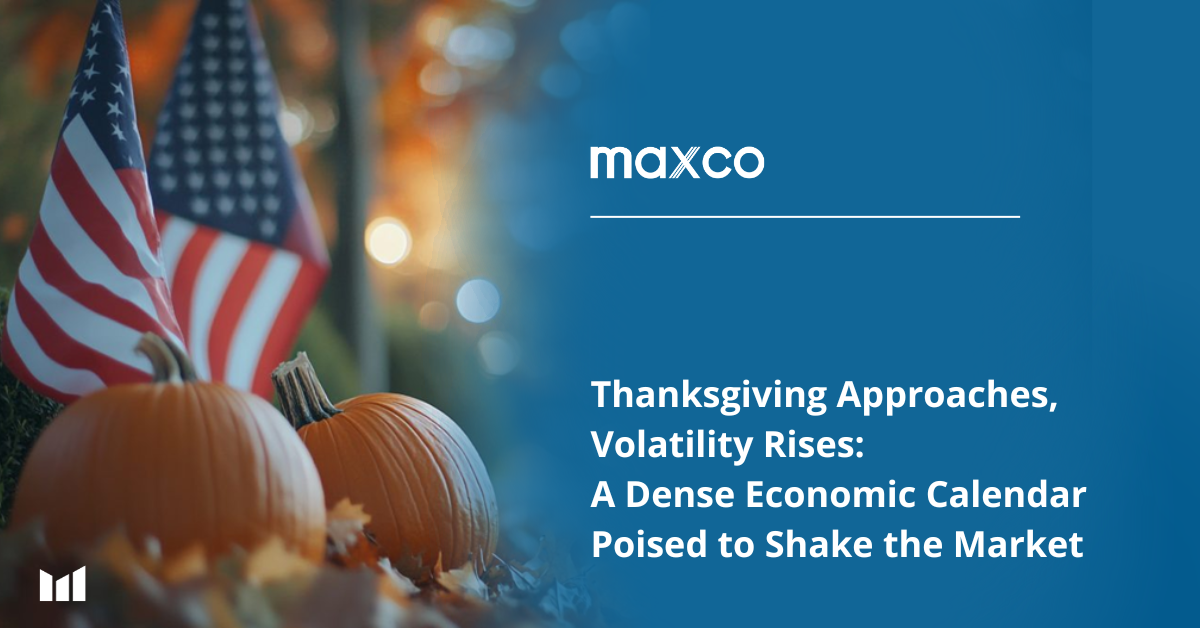Maxco Futures – The market enters the shortened Thanksgiving week with a defensive tone, following heavy pressure that dragged major indices below key technical levels. The sharp sell-off occurred despite Nvidia delivering a solid earnings report, underscoring the fading momentum in technology stocks that had previously fueled the rally. Bitcoin also plunged sharply—adding stress to speculative assets—before briefly rebounding on Friday as expectations for Federal Reserve rate cuts rose and reports emerged that Nvidia may resume chip sales to China. However, that optimism quickly dissipated toward the close.
Technical pressure is now at the forefront. With major moving averages being breached and buyer momentum weakening, investors have become more selective and shifted toward protective positioning. The market will need to show sustained recovery and reclaim lost support levels to shift the increasingly cautious tone.
This week, despite the shorter trading schedule, markets face a combination of a packed economic calendar, major earnings releases, and thin holiday liquidity—conditions that may amplify price movements.
U.S. Consumers Take the Lead
Tuesday opens the flow of key data with the release of September retail sales at 8:30 a.m. ET. This report will serve as a critical gauge of consumer spending ahead of the holiday shopping season—the most crucial period of the year for retailers. Market participants will focus on both headline and core retail sales to assess whether consumers remain resilient despite rising inflation, equity market volatility, and growing uncertainty in the labor market.
The Consumer Confidence report at 10:00 a.m. will provide further clarity. If household sentiment and spending show strength, the market may find new technical footing. Conversely, disappointing data could deepen concerns about an economic slowdown and prolong the ongoing weakness.
Wednesday’s Data Deluge: A Pivotal Moment for the Fed
Wednesday becomes the climax of the week, featuring a cluster of major releases—typically spread over several days—all arriving in one morning, just a day before markets close for Thanksgiving.
The agenda includes:
- Revised Q3 GDP
- The Fed’s preferred inflation gauge: Core PCE
- Durable goods orders
- Initial jobless claims
Meanwhile, the previous day’s Producer Price Index (PPI) will provide additional context on wholesale inflation.
With only one full trading day available to digest the data before the holiday, market reactions are likely to be sharp and unstable. Any surprise in inflation or economic activity could quickly alter monetary policy expectations for the December FOMC meeting—meaning heightened volatility.
Enterprise Tech Takes Center Stage in Earnings
Beyond macro data, earnings from three enterprise giants will offer essential insight into global technology spending:
- Dell – a pulse check on demand for AI servers, corporate PCs, and data center infrastructure—key components of post-AI growth narratives.
- Workday – will reveal trends in cloud-based HR software and enterprise digital transformation initiatives.
- Zscaler – as a cybersecurity leader, will signal whether CIOs are still prioritizing digital defense spending despite the possibility of budget tightening.
Forward guidance from these companies will help investors determine whether a tech-led rally can return or if pressure on growth stocks is just beginning.
China vs. U.S. Industrials: Two Economies, Two Narratives
Outside of tech, investors are also closely watching Alibaba’s earnings. Alibaba will shed light on the state of the Chinese consumer—still weighed down by geopolitical tension and signs of uneven recovery. Singles’ Day performance and the year-end outlook will be major areas of focus.
Holiday Liquidity: Bigger Moves, Higher Risks
The shortened week before Thanksgiving is typically marked by reduced trading volume, which can magnify market reactions to headlines and data releases. With markets closed on Thursday and a shortened session on Friday, institutional investors tend to be more cautious about opening new positions.
The key question is no longer just what data will come out—but how the market will respond amid thin liquidity and fragile technical structure.
Ade Yunus, ST WPA
Global Market Strategy
